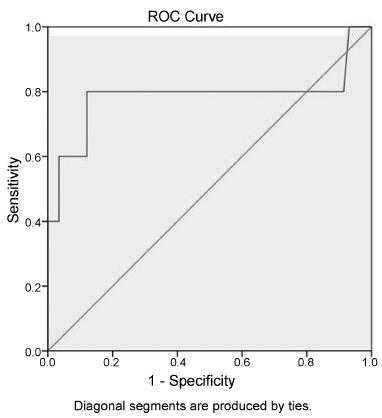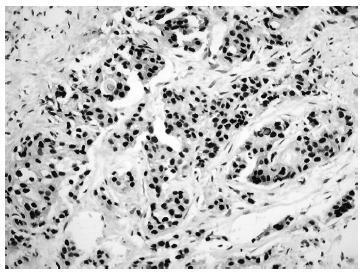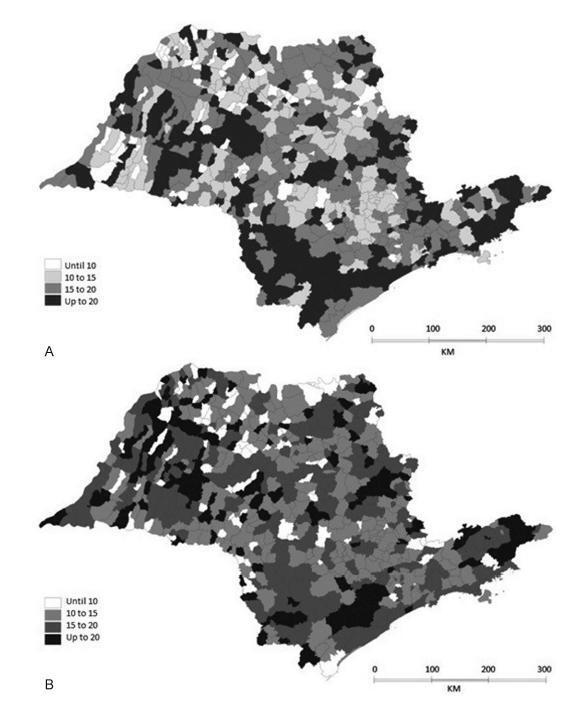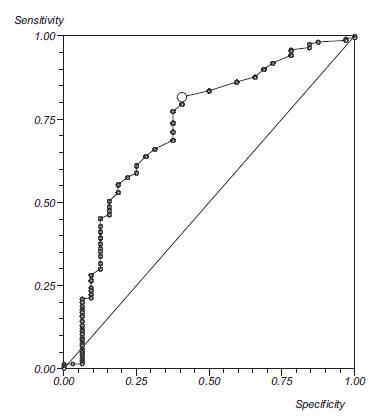Summary
Revista Brasileira de Ginecologia e Obstetrícia. 2016;38(12):585-588
Analyzing if the sonographic evaluation of the cervix (cervical shortening) is a prognostic marker for vaginal delivery.
Women who underwent labor induction by using dinoprostone were enrolled. Before the induction and three hours after it, the cervical length was measured by ultrasonography to obtain the cervical shortening. The cervical shortening was introduced in logistic regression models among independent variables and for calculating receiver operating characteristic (ROC) curves.
Each centimeter in the cervical shortening increases the odds of vaginal delivery in 24.4% within 6 hours; in 16.1% within 24 hours; and in 10.5% within 48 hours. The best predictions for vaginal delivery are achieved for births within 6 and 24 hours, while the cervical shortening poorly predicts vaginal delivery within 48 hours.
The greater the cervical shortening 3 hours after labor induction, the higher the likelihood of vaginal delivery within 6, 24 and 48 hours.

Summary
Revista Brasileira de Ginecologia e Obstetrícia. 2016;38(12):589-592
We speculate that genetic racial disparity exists in fetal life and can be detected by modern computerized cardiotocography (cCTG) .
This is a retrospective study comparing the results of the cCTG of pregnant patients at 37-42 weeks according to the parental ethnicity (black versus white). A cCTG was performed to analyze the variables of fetal heart rate (FHR). The cCTG variables analyzed were: percentage of signal loss; number of contractions; basal FHR; number of accelerations; number of decelerations; length of high variation episodes; short-term variability (STV); total trace duration time; and number of fetal active movements. Non-stress test (NST) parameters in the two groups were compared using the Mann-Whitney test for continuous data, and the Chi-square test for categorical variables.
We found a significantly lower number of active fetal movements (p 1/4 0.007) and longer periods of low variation (p 1/4 0.047) in the cCTG of black patients when compared with white patients.
In conclusion, identifying the factors responsible for the variance in the objective analysis of CTG results is important to improve the outcomes of patients. Our study lends further evidence as to the importance of ethnicity in clinical cCTG interpretation.
Summary
Revista Brasileira de Ginecologia e Obstetrícia. 2016;38(12):609-614
To assess depression, domestic violence and the use of substances in women with recurrent miscarriages.
The Abuse Assessment Screen (AAS), the Edinburgh Postnatal Depression Scale (EPDS) and the Alcohol, Smoking and Substance Involvement Screening Test (ASSIST) were used to assess violence, depression and the use of substances among women with recurrent miscarriages. The population corresponded to patients receiv-ing prenatal care from June to August 2014. Multiple logistic regression was used to assess the multivariable relationship between depression and sociodemographic, psychosocial and medical characteristics (p < 0,10).
The prevalence of depression was of 41.3% (95% confidence interval [CI] 1/4 28.3-55.7%). One third of the pregnant women (32.6%) reported emotional or physical violence, and 13% were classified as abusing or addicted to tobacco according to ASSIST. History of psychiatric diseases was associated with depression (p 1/4 0.005). Violence during life demonstrated a modest association (p 1/4 0.073) with depression, as well as the number of miscarriages (p 1/4 0.071).
Depression is a frequent disease among pregnant women with recurrent miscarriages. The results of this investigation suggest that a systematic assessment of depression and its associated conditions, such as domestic violence and the use of substances, should be part of the prenatal follow-up visits for women with recurrent miscarriages.
Summary
Revista Brasileira de Ginecologia e Obstetrícia. 2016;38(10):518-523
To translate into Portuguese, culturally adapt and validate the Uterine Fibroid Symptom - Quality of Life (UFS-QoL) questionnaire for Brazilian women with uterine leiomyoma.
Initially, the UFS-QoL questionnaire was translated into Brazilian Portuguese in accordance with international standards, with subsequent cultural, structural, conceptual and semantic adaptations, so that patients were able to properly answer the questionnaire. Fifty patients with uterine leiomyoma and 19 patients without the disease, confirmed by abdominal pelvic examination and/or transvaginal ultrasound, were selected at the outpatient clinics of the Department of Gynecology of the Universidade Federal de São Paulo (Unifesp). The UFS-QoL questionnaire was administered to all women twice on the same day, with two different interviewers, with an interval of 15 minutes between interviews. After 15 days, the questionnaire was readministered by the first interviewer. Reliability (internal consistency and test-retest), construct and discriminative validity were tested to ratify the questionnaire.
The reliability of the instrument was assessed by Cronbach’s α coefficient with an overall result of 0.97, indicating high reliability. The survey results showed a high correlation (p= 0.94; p 0.001).
The UFS-QoL questionnaire was successfully adapted to the Brazilian Portuguese language and Brazilian culture, showing reliability and validity.
Summary
Revista Brasileira de Ginecologia e Obstetrícia. 2016;38(10):512-517
Triple-negative breast carcinomas (TNBCs) represent a heterogeneous group of neoplasias, even though they generally exhibit a clinically more aggressive phenotype, and are more prevalent in young women. To date, targeted therapies for this group of tumors have not been defined. The aim of this study was to evaluate the frequency of the apocrine subtype in TBNCs from premenopausal patients as defined by the immunohistochemical expression of the androgen receptor (AR) and its association with: histological type; tumor grade; proliferative activity; epidermal growth factor receptor (EGFR) expression; and a basal-like phenotype.
A total of 118 tumor samples from patients aged 45 years or younger were selected and reviewed according to histological type and grade. Ki-67 expression was also evaluated. Immunohistochemical expression of the AR, basal cytokeratin ⅚, and EGFR expression were analyzed in tissue microarrays. The apocrine subset was defined by AR-positive expression. The basal-like phenotype was characterized by cytokeratin ⅚ and/or EGFR expression.
An apocrine profile was identified in 6/118 (5.1%) cases. This subset of cases also exhibited a lower rate of Ki-67 expression (17.5% versus 70.0%, p= 0.02), and a trend toward a lower histological grade (66.7% versus 27.9%, p= 0.06).
The apocrine subtype of TNBCs is rare among premenopausal women, and it tends to present as carcinomas of lower grade and lower proliferative activity, suggesting a less aggressive biological phenotype.

Summary
Revista Brasileira de Ginecologia e Obstetrícia. 2016;38(10):506-511
To evaluate the accuracy of transvaginal ultrasonography, hysteroscopy and uterine curettage in the diagnosis of endometrial polyp, submucous myoma and endometrial hyperplasia, using as gold standard the histopathological analysis of biopsy samples obtained during hysteroscopy or uterine curettage.
Cross-sectional study performed at the Hospital Universitário de Brasília (HUB). Data were obtained from the charts of patients submitted to hysteroscopy or uterine curettage in the period from July 2007 to July 2012.
One-hundred and ninety-one patients were evaluated, 134 of whom underwent hysteroscopy, and 57, uterine curettage. Hysteroscopy revealed a diagnostic accuracy higher than 90% for all the diseases evaluated, while transvaginal ultrasonography showed an accuracy of 65.9% for polyps, 78.1% for myoma and 63.2% for endometrial hyperplasia. Within the 57 patients submitted to uterine curettage, there was an accuracy of 56% for polyps and 54.6% for endometrial hyperplasia.
Ideally, after initial investigation with transvaginal ultrasonography, guided biopsy of the lesion should be performed by hysteroscopy, whenever necessary, in order to improve the diagnostic accuracy and subsequent clinical management.
Summary
Revista Brasileira de Ginecologia e Obstetrícia. 2016;38(10):492-498
To identifying spatial patterns in the distribution of perinatal mortality in the state of São Paulo from 2003 to 2012.
An ecological and exploratory study with data on perinatal mortality rates of every thousand live births, which were registered on the digital database containing 645 municipalities in the state of São Paulo within the periods of 2003 to 2007 and 2008 to 2012. The spatial analysis provided Moran’s index (MI) and thematic maps of rates, and the Moran maps of both periods were drawn. The average rates were compared by Student’s t test. The TerraView 4.2.2 software (INPE, S. José dos Campos, Brazil) was also used.
There were 49,485 perinatal deaths during the first period, at a rate of 17.90 deaths/1,000 live births (standard deviation [SD] = 7.0; MI = 0.14; p = 0.01), and 44,582 perinatal deaths during the second period, at a rate of 16.40 deaths/1,000 live births (SD = 11.14; MI = 0.04; p = 0.03). These rates are statistically different (p < 0.01). There was a decrease in these rates in 413 municipalities when comparing the two periods. The Moran map has identified 35 municipalities that require special attention, which are located in the Eastern, Southwestern, Western and Northwestern regions of São Paulo state.
The study provides municipal managers with subsidies so they can minimize these rates by implementing public policies and taking better care of pregnant women and newborns.

Summary
Revista Brasileira de Ginecologia e Obstetrícia. 2016;38(10):499-505
To identify which methods used in the assessment of the ovarian reserve are exclusive or complementary to identify the best response to follicle development.
Retrospective cohort study, involving patients undergoing assisted reproduction treatment at the Instituto de Medicina Reprodutiva e Fetal, from April 2009 to July 2014. Age, biochemical tests, and ultrasound were assessed. The data were analyzed to predict the follicular development and the relation between them, using, for statistical analysis, Statistical Package for Social Sciences software.
Out of the 293 couples included, 50.2% presented infertility by ovarian factor. Considering the age as the main variable, a significant negative correlation with the volume of both ovaries was observed (right ovary, r = 0.21; left ovary, r =0.22; both p< 0.0001), and with the antral follicle count (right ovary, r =0.38; left ovary, r =0.47; both p< 0.0001). Considering the antral follicle count as the main variable, a significant positive correlation with the total recruited oocytes was observed. When we correlated the antral follicle count with the recruited follicles larger than 18 mm, we observed that, with a cutoff of 12 antral follicles, there is a positive predictive value of 99%, and an area under the ROC curve of 0.76.
We concluded from our study that age and antral follicle count are effective predictors of ovarian response in cycles of assisted reproduction. The ovarian volume, as well as the anti-Müllerian hormone dosage, seem to be adequate markers of the ovarian reserve.
